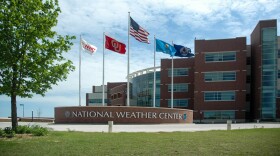Oklahoma’s Spanish speakers have more access to severe weather information now than they did two years ago when tornadoes ripped through Moore and other parts of the Oklahoma City metro. But despite the improvements, gaps in communication remain.
A few months ago, Jesus Lopez became the only certified Spanish-speaking broadcast meteorologist in Oklahoma. Before he started his gig at the local Telemundo affiliate Acción Oklahoma, the 26-year old was an elementary school science teacher in his hometown of Miami, Florida. He uses that classroom experience to educate viewers about severe weather, keeping the terminology basic and using lots of visuals.
“I know for a fact that I will start changing people’s mentality to be weather aware,” Lopez said while demonstrating some the station’s weather forecasting software. “Not to change it drastically, just to always be weather aware, especially here in Oklahoma.”
The fact that Lopez is here is a big step toward improving severe weather information for Oklahoma’s Spanish speakers. A tornado and the ensuing flooding on May 31, 2013 killed over 20 people, including a Guatemalan family who drowned after taking cover in a drainage ditch. A National Weather Service assessment found a lack of warning and forecasting resources in Spanish and residents weren’t prepared.
At the time, the local Telemundo affiliate didn’t have a meteorologist.
“Unfortunately a big event had to happen, but things are getting better,” Lopez said. “For example, last week we had three tornadoes in the metroplex and I was here seven hours in a row on live TV telling them what was going to happen.”
The Red Cross now has a Spanish tornado recovery smartphone app and Red Cross leaders opened a shelter with bilingual volunteers after the most recent tornado outbreak. Jesus Lopez reaches out to his audience on Facebook and distributes a Spanish storm preparedness pamphlet. Spanish radio stations broadcast Lopez’s wall-to-wall severe weather coverage.
But there are still barriers. Rick Smith, the warning coordination meteorologist at the National Weather Service in Norman, said his agency posts some weather alerts on its website in Spanish, but those are computer-based translations and some things are lost in translation, like the meaning of a watch and a warning.
“When we are talking life and death messages, of whether to seek shelter underground from a tornado or whether to get to higher ground because of a flash flood, the nuances and the different layers of meaning in some of those messages can literally make the difference between life and death,” Smith said.

English speakers have several television and radio stations, and a whole bunch of social media tools, the Twitter hashtag okwx, websites and other sources of instantaneous information, like push notifications. If the power goes out, there are other ways to get info. Spanish speakers have less to rely on.
“That’s an issue," Smith said. "It is more difficult to have that redundancy, to have those multiple layers of information that we really encourage people to have.”
Two weeks ago, on May 6, a tornado struck the Oklahoma City metro. Laura Ortega said she was watching television when the weather turned severe, took some things out of the closet and took cover there.
“I stayed in there and watched television,” Ortega said in Spanish. “Everything that was happening.”
The channel she was watching, Channel 9, broadcasts in English.
“Because they were monitoring the rotation, where the tornado was forming and they were watching were it was going,” she said.
Ortega has lived in Oklahoma for 21 years and that’s the weather coverage she’s always watched.
Joy Pendley, a researcher at the University of Oklahoma, is leading a class that’s finding ways to improve severe weather communication with the Spanish speaking community. She said Hispanics in Oklahoma are still learning to trust Telemundo’s local weather coverage
“There’s still higher levels of trust in the English media even though the people don’t understand English,” Pendley said. “That will take time in the community for the Spanish media to build that trust, but I think they are doing the positive things to build that.”
Nobody knows the number of certified Spanish speaking broadcast meteorologists in the United States. The American Meteorological Society estimates there are about a dozen, but there could be more. As Jesus Lopez sees it, the supply is not meeting the demand.
“In the United States, the Hispanic community is growing but not the meteorologists,” Lopez said.
Not enough meteorologists to prepare speakers of the country’s second most common language.
-------------------------------------
KGOU relies on voluntary contributions from readers and listeners to further its mission of public service to Oklahoma and beyond. To contribute to our efforts, make your donation online, or contact our Membership department.








